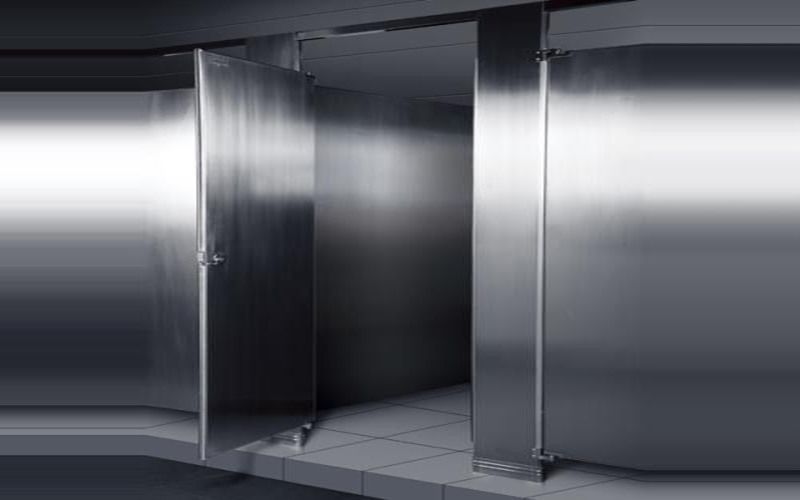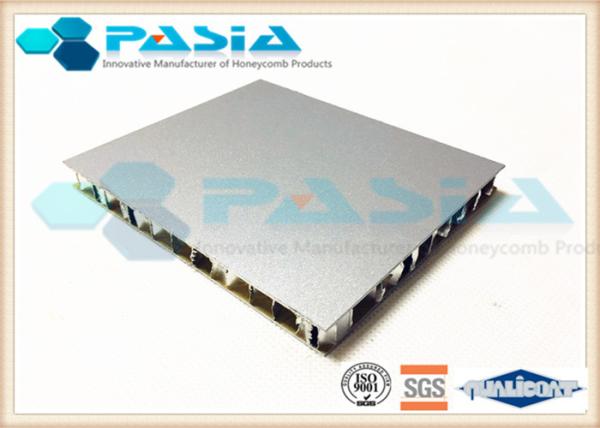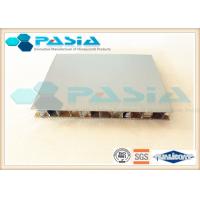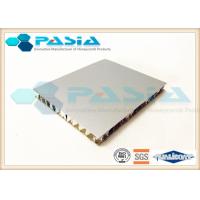Stainless Steel Aluminum Honeycomb Panel for the Elevator or Lifter
Wall or Floor Panels
Product Description
The Stainless Steel Aluminum Honeycomb Panel for the elevator or
lifter wall or floor panels are with the regular stainless steel
solid panel performance but with much lighter weight and flatter
surfaces.
It possesses good properties as below:
Oxidation
High oxidation resistance in air at ambient temperature is normally
achieved with additions of a minimum of 13% (by weight) chromium,
and up to 26% is used for harsh environments. The chromium forms a
passivation layer of chromium(III) oxide (Cr2O3) when exposed to
oxygen. The layer is too thin to be visible, and the metal remains
lustrous and smooth. The layer is impervious to water and air,
protecting the metal beneath, and this layer quickly reforms when
the surface is scratched. This phenomenon is called passivation and
is seen in other metals, such as aluminium and titanium. Corrosion
resistance can be adversely affected if the component is used in a
non-oxygenated environment, a typical example being underwater keel
bolts buried in timber.
When stainless steel parts such as nuts and bolts are forced
together, the oxide layer can be scraped off, allowing the parts to
weld together. When forcibly disassembled, the welded material may
be torn and pitted, an effect known as galling. This destructive
galling can be avoided by the use of dissimilar materials for the
parts forced together, for example bronze and stainless steel, or
even different types of stainless steels (martensitic against
austenitic). However, two different alloys electrically connected
in a humid environment may act as Voltaic pile and corrode faster.
Nitronic alloys made by selective alloying with manganese and
nitrogen may have a reduced tendency to gall. Additionally,
threaded joints may be lubricated to prevent galling.
Acids
Stainless steel is generally highly resistant to attack from acids,
but this quality depends on the kind and concentration of the acid,
the surrounding temperature, and the type of steel. Type 904 is
resistant to sulfuric acid at room temperature, even in high
concentrations, type 316 and 317 are resistant below 10% and 304
should not be used at any concentration. All types of stainless
steel resist attack from phosphoric acid, 316 and 317 more so than
304; and Types 304L and 430 have been successfully used with nitric
acid. Hydrochloric acid will damage any kind of stainless steel,
and should be avoided.
General Description
Stainless Steel Honeycomb Panel is comprised with two stainless
steel plates and one aluminum or stainless steel honeycomb core
layer. The upper surface can be colorful oxidation film coated or
diamond anti-skidding pattern stainless steel plates. The colorful
oxidation film performs well on corrosion resistance and cannot be
peered off by mechanical friction.
In metallurgy, stainless steel, also known as inox steel or inox
from French "inoxydable", is a steel alloy with a minimum of 10.5%
chromium content by mass.
Stainless steel does not readily corrode, rust or stain with water
as ordinary steel does. However, it is not fully stain-proof in
low-oxygen, high-salinity, or poor air-circulation environments.
There are different grades and surface finishes of stainless steel
to suit the environment the alloy must endure. Stainless steel is
used where both the properties of steel and corrosion resistance
are required.
Stainless steel differs from carbon steel by the amount of chromium
present. Unprotected carbon steel rusts readily when exposed to air
and moisture. This iron oxide film (the rust) is active and
accelerates corrosion by forming more iron oxide; and, because of
the greater volume of the iron oxide, this tends to flake and fall
away. Stainless steels contain sufficient chromium to form a
passive film of chromium oxide, which prevents further surface
corrosion by blocking oxygen diffusion to the steel surface and
blocks corrosion from spreading into the metal's internal
structure, and, due to the similar size of the steel and oxide
ions, they bond very strongly and remain attached to the surface.
Characteristics:
| No. | Properties |
| 1 | Variety of colors for selection with various of pattern |
| 2 | Good corrosion resistance, greatly better than the stainless steel
of the same type and the original color. |
| 3 | Heat Resistance, soaked in boiling water for 28 days or exposed at
the 200 °C for long time, no change on the color and luster. |
| 4 | Abrasion resistance and good scratch performance, no color change
after eraser friction more 2000 times at the pressure 500g/cm2. |
| 5 | film flexibility, after 180°T bend test and 8mm cupping test, film
is without any change. |
| 6 | Scrubbing resistance, applicable on washing with any organic
solvent, neutral detergent or water if there is dirt on the
surface. |
| 7 | Anti-pollution performance, the surface can be restored by washing. |
| 8 | aging resistance better than regular stainless steel |
| 9 | possessing advantages of the honeycomb panel: 1) lower density and
big flexural rigidity; 2) super flat surface; 3) good performance
on sound absorption and insulation as well as thermal insulation |
| 10 | safe on fire resistance: A2 grade |
| 11 | environmental: recyclable |
Application
Applicable on hotel, entertainment venues, high level exclusive
shops, elevator panel, hall wall panel, carriage panel, backdrop,
ceiling, decoration and signboard.










